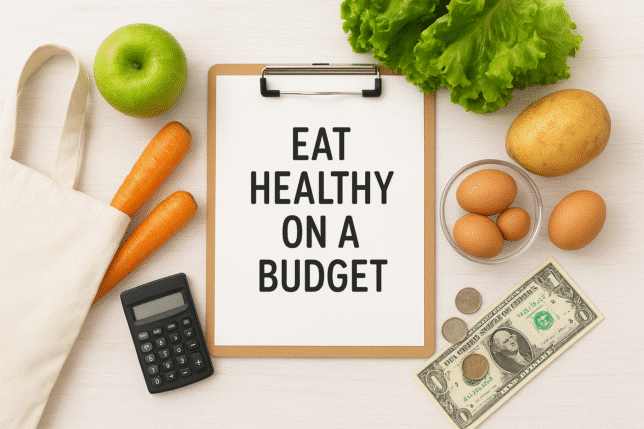Eating healthy doesn’t have to break the bank. You can nourish your body with real, whole food without overspending—it simply takes a little planning, creativity, and time. The truth is, time is money, but when it comes to nutrition, spending a bit more time can actually save you money.
So, how to eat well on a budget?
A lot of people assume that healthy eating requires specialty ingredients or expensive organic brands, but real nutrition can come from the simplest, most affordable foods.
Even resources like the USDA’s MyPlate Healthy Eating on a Budget show how everyday staples can fuel your body without stretching your wallet.
When you slow down, look at what’s available, and make intentional choices, you start to realize that eating well is much more about habits than price tags.
And once you get into a rhythm—shopping a little smarter, prepping things yourself, and making use of eating tips with what you already have—you begin to feel more in control of both your health and your wallet.
Five Simple Ways: How to Eat Well on a Budget
1) Shop Smart and Do It Yourself
Convenience comes at a cost. Pre-cut fruits and vegetables may save a few minutes, but they also cost significantly more. Instead, buy whole produce and prep it yourself.
- Slice your own apples, celery, or carrots for grab-and-go snacks.
- Buy whole heads of romaine or iceberg lettuce and chop them at home instead of paying extra for bagged salad kits.
A few minutes of prep work each week can lead to meaningful savings and is one of the easiest ways to eat well on a budget.
2) Buy In-Season and Affordable Staples
Fruits and vegetables are often cheaper when they’re in season—and they taste better, too. Staples like potatoes, carrots, and cabbage are inexpensive year-round and can be used in endless ways: soups, stir-fries, roasted sides, or hearty salads.
And when your fruits and veggies start to look past their prime, don’t toss them!
- Overripe fruit can be frozen for smoothies or baked goods (frozen bananas make the creamiest smoothies and the best banana bread).
- Aging veggies can be diced and added to soups, casseroles, omelets, or pasta sauces for an antioxidant boost and less food waste.
3) Choose Budget-Friendly Proteins
Protein doesn’t have to be pricey. A few simple swaps can stretch your dollar without sacrificing nutrition:
- Ground turkey is typically about half the cost of ground beef.
- Bone-in, skin-on chicken (or thighs and drumsticks) offers great flavor, healthy fats, and savings compared to boneless cuts.
- Eggs, beans, and lentils are other inexpensive protein sources that can anchor satisfying meals.
These swaps are reliable ways to eat healthy on a tight budget without compromising on nutrients.
4) Stretch Your Meals with Affordable Carbs
Budget-friendly staples like potatoes, rice, and quality pasta can help make meals more filling. Just be mindful of portions and aim for balance—pair your carbs with plenty of vegetables and protein for lasting energy and healthier meals overall.
5) Plan Ahead and Use Leftovers
A little meal planning goes a long way. Set aside time each week to plan your grocery list, prep some ingredients, and even cook a few meals ahead.
When you’re already making dinner, double the recipe—leftovers make perfect grab-and-go lunches or quick dinners for busy nights. Planning ahead is one of the most effective ways to eat well on a budget because it prevents impulse buys and reduces food waste.
The Payoff: Health and Freedom
Saving money at the grocery store doesn’t mean sacrificing health or taste. By investing time and thought into what you eat, you can nourish your body, protect your wallet, and reduce future healthcare costs.
So, think long-term. Spend wisely, eat simply, and enjoy more time on this beautiful planet, living well and feeling good.
Small changes really do add up. When you choose whole ingredients, repurpose leftovers, and build meals around nourishing staples, you create routines that support your well-being without draining your budget. And the more consistently you do it, the more natural it becomes.
Your body feels better, your meals feel satisfying, and your money stretches further. That’s the real payoff—freedom, health, and the peace of knowing you’re taking good care of yourself in a sustainable, realistic way.
Amanda Brink Hull grew up in rural Iowa, where early lessons in real food, hard work, and authentic living shaped her lifelong commitment to wellbeing. Now residing full-time in Florida, she shares the gift of health with individuals and organizations across the country. A certified personal trainer, nutritionist, health coach, and holder of a master's in Industrial and Organizational Psychology, she founded Hull Health to help people thrive through simple, sustainable wellness. Amanda is also a seasoned marketing professional and the author of Rooted: The Down-to-Earth Basics of Wellness.


















